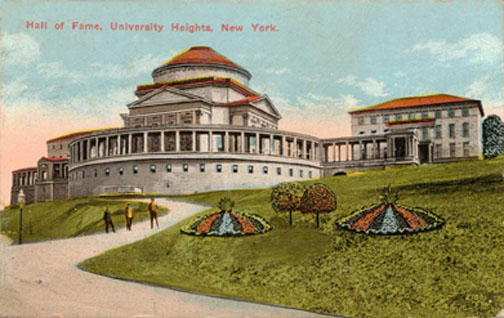The Hall of Fame For Great Americans
Stanford White chose to locate Gould Memorial Library on a high plateau overlooking the Harlem River. This location exposed a large portion of the building’s rear foundation wall which he planned to conceal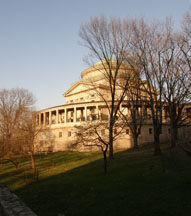 with a curved colonnade. The colonnade would form a walkway to the two other buildings he designed: The Hall of Language and the Hall of Philosophy, which flank the library (Ultan 8). with a curved colonnade. The colonnade would form a walkway to the two other buildings he designed: The Hall of Language and the Hall of Philosophy, which flank the library (Ultan 8).
Henry MacCraken, however, envisioned the colonnade area as more than just a walkway. For several years MacCraken bemoaned that there was no commemoration of people who had made great contributions to American history. His idea, which he named a “Hall of Fame For Great Americans,” sought to create a pantheon of great Americans who achieved fame because of their significant accomplishments, not because of their celebrity (Rubin 14). The Hall of Fame on BCC’s campus, which is a New York City Landmark and listed on the National Register of Historic Places, was the first hall of fame conceived. From here the idea would spread to cities around the world and to fields as diverse as baseball and rock and roll (Rubin 16).
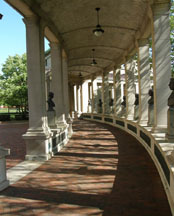 White structured an outdoor colonnade that stretches 630 feet that is open on both sides and lined with granite columns that form 102 niches. Its 10 foot wide brick walkways are shielded under vaulted ceilings lined with Guastovino tiles (Bronx Community College Hall of Fame For Great Americans). Outdoor ornamentation suggestive of Greek and Roman stoas reveal again White’s neoclassic Beaux Arts White structured an outdoor colonnade that stretches 630 feet that is open on both sides and lined with granite columns that form 102 niches. Its 10 foot wide brick walkways are shielded under vaulted ceilings lined with Guastovino tiles (Bronx Community College Hall of Fame For Great Americans). Outdoor ornamentation suggestive of Greek and Roman stoas reveal again White’s neoclassic Beaux Arts 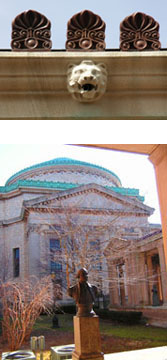 style. style.
The first inductees in 1900 were honored with tablets designed by the Louis Comfort Tiffany Studios (Grundfest 9). In 1907 portrait busts along with a tablet began commemorating each inductee (Grundfest 12). Today the Hall of Fame houses 98 busts and contains the works of such noted sculptors as Augustus Saint-Gaudens, Daniel Chester French and Frederick MacMonnies. The National Sculpture Society has called it the finest collection of bronze busts in America (Sheraton E47).
In addition to coining the term hall of fame, MacCraken set democratic rules governing the induction of honorees.
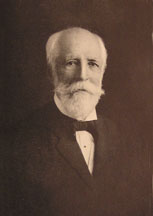 |
| Henry MacCraken |
First, he wanted individuals from various fields not just legislators or politicians. He placed no limitations with regard to sex, race or religion only stipulating that a nominee had to be dead for at least twenty-five years. Since this was an American pantheon he originally proposed that all honorees must be born in America; however this was soon amended to include any American citizen by birth or naturalization. Originally, there were sixteen fields in which individual accomplishment was honored that were later reduced to 5: (1) Arts, (2) Sciences, (3) Humanities, (4) Government and (5) Business and Labor (Grundfest 14). MacCraken then wisely involved the American public in the process by allowing them to nominate any individual they deemed worthy. A board of electors composed of leaders from various fields then voted on the nominees. An individual who received a majority of this body’s votes was then inducted (Grundfest 11).
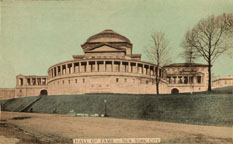 During the 1920’s and 30’s newspapers around the United States ran editorials encouraging readers to nominate individuals. Organizations as diverse as the Daughters of the Confederacy and the American Bar mounted efforts to seek votes for candidates. As the images of the postcards suggest the Hall of Fame became a major tourist attraction hosting as many as 50,000 visitors a year. Richard Rubin writing in The Atlantic Monthly states that at one time ”the term “Hall of Famer“ carried greater cachet than ” Nobel laureate” (Rubin 16). This only true American pantheon received the ultimate honor in contemporary America—mention in a major Hollywood movie. In MGM’s 1939 “The Wizard of OZ,” after Dorothy’s house has crushed the Wicked Witch of the East the now liberated Munchkins celebrate her great accomplishment singing: During the 1920’s and 30’s newspapers around the United States ran editorials encouraging readers to nominate individuals. Organizations as diverse as the Daughters of the Confederacy and the American Bar mounted efforts to seek votes for candidates. As the images of the postcards suggest the Hall of Fame became a major tourist attraction hosting as many as 50,000 visitors a year. Richard Rubin writing in The Atlantic Monthly states that at one time ”the term “Hall of Famer“ carried greater cachet than ” Nobel laureate” (Rubin 16). This only true American pantheon received the ultimate honor in contemporary America—mention in a major Hollywood movie. In MGM’s 1939 “The Wizard of OZ,” after Dorothy’s house has crushed the Wicked Witch of the East the now liberated Munchkins celebrate her great accomplishment singing:
| |
“You will be a bust,
'be a bust,
be a bust in the Hall of Fame"
(Sheraton E57) |
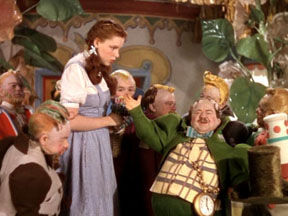 |
The last elections into the Hall of Fame occurred in 1976 (Sheraton E47). By this time, the budgetary issues of acquiring bronze sculptures along with a general lack of public interest and donations helped end an institution that lasted 75 years. When the Hall of Fame was listed in the National Register of Historic Places a writer noted:
| |
“The purpose of the Hall of Fame was not to mourn the passing of heroes, but to inspire the living"(Morley25).
|
|
Perhaps in our modern age of celebrity culture we have lost site of the true meaning of heroism and accomplishment.
Footnote
Interestingly the rule mandating the American citizenship of honorees was bent slightly in 1932 when the Hall Of Fame accepted a replica of Houdon’s bust of the Marquis de Lafayette. This bust however does not sit in the Hall Of Fame but behind it in a niche in the back wall of Gould Memorial Library.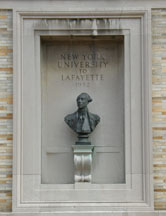
Works Cited
Bronx Community College Hall of Fame For Great Americans. 2011. 5 April 2011 <http://www.bcc.cuny.edu/halloffame/?page=Architecture>.
Grundfest, Jerry. Great Americans - A Guide to the Hall of Fame For Great Americans. New York: New York University, 1977.
Morley, C. B. "A Century of Celebrating Greatness." The BronxTimes 4 January 2001: 25.
Rubin, Richard. "The Mall of Fame." The Atlantic Monthly (July 1997): 14 - 18.
Sheraton, Mimi. "MY BRONX; Yesterday's Heros, Up On Pedestals." The New York Times 15 December 2000: E57.
Ultan, Lloyd. "Bronx Movers and Shakers VI: Henry Mitchell Cracken." Bronx Press 12 August 2010: 8.
Photo Credits
     Jones, Theodore Francis. New York University 1832 : 1932. New York: The New York University Press, 1933. Jones, Theodore Francis. New York University 1832 : 1932. New York: The New York University Press, 1933.
 http://parodyfiles.com/?p=2083 http://parodyfiles.com/?p=2083
|

